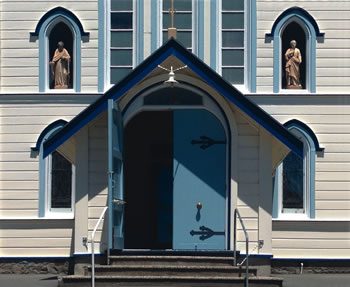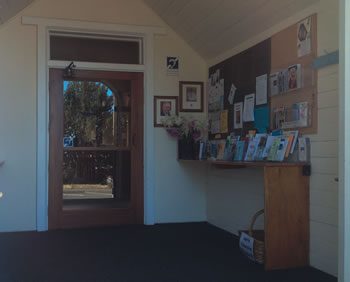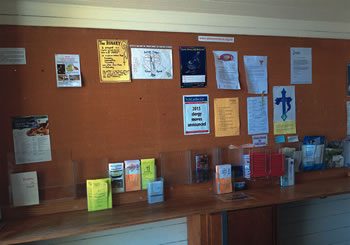Reading a Church
Part 2: The Entrance
When you step through the doorway of a church you are leaving the outer-world behind and entering an inner world. The outside world is a fair place abounding in life and activity, but also a place with a mingling of the base and ugly. It is a sort of market place, crossed and re-crossed by all and sundry. Perhaps “unholy” is not quite the word for it, yet there is something profane about the world. Behind the church doors is an inner place, separated from the market place, a silent, consecrated and holy spot. - Romano Guardini
Last issue we looked at the exterior of St Mary’s Church in Nelson as a fine example of early New Zealand church architecture. It stands out on its site, a distinctive building that leads the eye and heart to heaven. Let’s now mount the three steps (Father, Son and Holy Spirit) and step across the threshold of the impressive double doors.
The doors, especially when both are open, are inviting but they also channel everyone through a relatively narrow main entrance. I found when doing the “meet and greet” outside them that everyone came past quite slowly. It is not an easy church to hurry out of, at least by way of the main door – there are two side entrances. One of the side entrances is easier for wheelchair access and the main steps do have hand rails – physical signs that this church is not out to exclude those with mobility issues.
Just like the exterior, the entrance of St Mary’s is influenced by the guidelines given by St Charles Borromeo after the Council of Trent. His ideal is for an atrium, if you can’t afford that you should have a pillared portico running right across the façade of the church, but then he concedes:
If for lack of funds not even this is possible, at least a square porch should be built in front of the main door, with only two columns or piers set far from the door. It will be a bit wider than the entrance to the church.
The porch acts as a transition zone between outside and inside, between the world and the church.
Given that almost everyone enters by the main door, it is a place where subtle signs of inclusion and exclusion can be very effective. Sometimes these can be unintentional. Labelling a mass as “The Family Mass” may be intended to be welcoming, but singles and separated people can take it as a sign that it is not for them. Have a look at the accompanying photo and see what signals this particular church porch sends. Then look at the entrance of your own parish church and consider what messages it conveys.
The door through into the church is largely glass enabling you to see further in. The return spring ensures it keeps the wind out. Both on the glass and by the door are signs about a hearing loop. The hard-of-hearing are catered for by the sound system of this church. For many older parishioners this is very significant. Beside the door is a photo of Archbishop John Dew, strategically placed on a lower level than the photo of Pope Francis. As you enter this parish church you are being reminded that it belongs to a diocese and to the universal Church. The bunch of flowers in a vase may simply have been placed in the most sheltered spot, but they look as if they honour these two leaders as well as welcome us. There is the St Vincent de Paul basket soliciting donations of food for the needy – this is a community engaged in good works as well as in prayer. The noticeboard has information about events of interest to the church community, as well as an exhortation to join a small group who pray the rosary before mass. There are Catholic periodicals (including the Marist Messenger) and flyers about different organisations. I was struck by the presence of free pamphlets about the history of this particular church and about its archives. This is a community proud of its own history. There are coat hooks suggesting that it is safe place to hang up your hat or raincoat.
On the other wall of the porch is an advertisement for theology study at Otago University, for a mass at Totara Point, for a Retreat, more pamphlets, a notice about a parish prayer group, a winning artwork by a child at the parish school, the Caritas newsletter and a sign encouraging you to take a copy of The Far East. There are Psalm books for daily mass-goers and the photocopy of a page of the Ordo indicating what today’s readings and psalm are. At the top of all this is the web address for the parish website www.stmarysnelson.org.nz which is worth a look; very welcoming, informative and well laid out.
The subtle signals conveyed by this church porch are that the community who gathers here welcomes young and old, takes the liturgy seriously, belongs to something much bigger than itself and is very seriously into prayer and holiness.
Before Sunday Mass when you step through the next door you will be met by a pair of “greeters” who will hand you a copy of the parish newsletter – here called The Parishioner – but more of that in our next issue.



 Entries(RSS)
Entries(RSS)